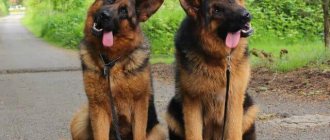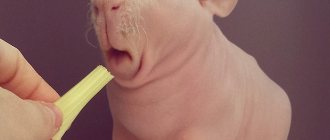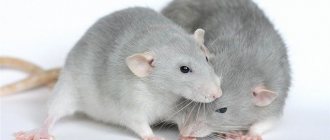A puppy's small age does not mean that he needs less attention and training.
Especially when it comes to German Shepherds.
This breed can become a true friend and protector.
But only if you start caring for and training him from a young age.
But this also has its own characteristics.
Let's find out about everything in detail.
Further in the article, detailed information on the care and education of a puppy will be provided.
What does a German Shepherd look like at 3 months?
At three months it becomes clearly visible that the puppy belongs to the German Shepherd breed. The dog's eyes and gaze become expressive. Other external parameters of a German puppy at 3 months include:
- The skull and body are proportional to each other, the frontal bone is slightly convex.
- The nose is bright black. German Shepherds are characterized by a small hump on their nose. Having noticed it in a puppy, you can be one hundred percent sure that this is a purebred German.
- Scissor bite of the anterior teeth.
- Ears begin to rise.
- Coarse, thick wool, colored in characteristic black and brown tones.
In addition, the puppy itself begins to quickly increase in size: its hind limbs and tail grow, its joints and muscles become more powerful. At three and a half months, the German cat sheds its first coat.
How to distinguish a breed from a crossbreed or mongrel
The surest way to purchase a purebred German Shepherd is to do so from a reliable kennel. Then the puppy will have a pedigree, a metric (puppy card), a brand with a unique number in the groin or on the ear. And you won’t have to guess whether you bought a purebred dog or not. When buying from private breeders or on the market, there is always a risk of making a mistake, because an amateur is unlikely to be able to correctly evaluate the breed. In this case, decide on the purpose: why you need a dog. To participate in exhibitions and breeding work, you need to look for a puppy only in nurseries with a good reputation. For official or security work - in the same place, because the character of a real German Shepherd, which made it a legend and a movie star, is also a sign of the breed. But then appearance is not so important, and the dog will cost much less.
The new owner signs the puppy inspection report (below) and the certificate is certified with a seal
If you want to have a companion dog with the appearance of a German Shepherd, then you can take the risk of purchasing it on the market or through “buy and sell” advertisements, but at the same time remember that a grown-up pet may unpleasantly surprise you with its difference from true “Germans”. There are signs by which you can try to distinguish a purebred puppy from a mestizo or mongrel:
- “Germans” have almond-shaped eyes with snow-white whites, while mongrel dogs have round, sometimes convex, eyes with yellowish whites or dark spots;
- an ordinary puppy cannot boast of a perfectly smooth topline and a body elongated like a torpedo;
- the tail of a small shepherd never rises above the line of the back and does not curl into a ring, like that of mongrels;
- The ears of a “German” should be floppy and soft for at least 4–5 months, while a mongrel’s ears may stand up at any time or not at all;
- A purebred baby does not have a stripe between the eyebrows (frontal furrow) on the forehead, but a purebred baby may have one;
- A shepherd puppy grows and develops much faster than a yard puppy, so at the same age he will weigh more and look more mature.
A “German” puppy is more inclined to communicate with a person than a mongrel puppy
Video: how to choose the right German Shepherd
Dog character and behavior
Although the three-month-old German Shepherd is slowly starting to mature, she is still a child. Therefore, constant pampering and restlessness are her faithful companions. At 3 months old, he needs somewhere to put his energy.
It is important at this age to show mastery persistence and explain to the child what behavior is inappropriate. Otherwise, the four-legged “rocket” will ruin all the things in the house, including furniture.
At 3 months, it’s time to teach the black German Shepherd to respond appropriately to random passers-by, other dogs and animals. But you don’t need to take your baby to noisy and crowded places for this. After all, his psyche is just beginning to form, and such a situation will make the German timid and twitchy.
How to care for your pet?
- To keep your pet healthy, regular hygiene is necessary. Ears are cleaned once every two weeks.
To do this, apply a special product to a cotton pad and gently clean the ear. If the color of the discharge is yellow, it means everything is in order. But if the discharge is dark in color, contains pus, or has an unpleasant, pungent odor, contact your veterinarian. - You need to brush your shepherd twice a week. If the molting period has arrived - every day.
- Pay attention to your eyes. Dogs of this breed are not prone to eye diseases, but if you notice purulent discharge, redness or swelling, contact a specialist immediately.
- At the age of 2 months, begin to accustom your shepherd to cutting his nails. Lay the animal on its side or sit it down. Fix the chosen position and remove 2-3 mm of the nail with a special tool. Be careful not to touch the blood vessels. If you get it and start bleeding, treat the nail with peroxide.
- During the year, the dog is taken for vaccinations three times.
- At 1 month of age, begin introducing complementary foods. This can be either dry specialized food, soaked in water, or chopped, lean meat (rabbit, turkey). Kefir and cottage cheese are also allowed. Upon reaching 1.5 months, introduce porridge (rice and oatmeal). The meat can be cut into small pieces.
By the 3rd month it is necessary to introduce vegetables. First boiled, and after some time - raw.Number of meals:
- up to 2 months – 6 times;
from 2-3 months – 5 times;
- from 3-6 months – 3 times;
- from 6 months – 2 times.
Feeding a 3 month old German Shepherd puppy.
The daily diet of a German Shepherd puppy can be natural food and dry food. Which of the two options is better is up to the dog owner to decide.
Natural feeding
To feed your Black Longhaired German Shepherd puppy natural food correctly, it is important to follow a whole list of rules:
- The food served should be at room temperature. Do not give your baby hot or cold food.
- You need to cut food into small pieces. Puppies sometimes choke on large pieces, because Germans do not chew their food, but swallow it whole.
- It is necessary to establish the same feeding time every day.
- The dog should not be allowed to overeat. Among the consequences of overfeeding are intestinal volvulus and severe dehydration.
- Every day you need to change the drinking water in the bowl and place it in an accessible place.
The composition of a natural menu for a three-month-old puppy must contain:
- Maximum meat. Thanks to protein, the dog grows quickly and develops properly. A German needs lean beef, turkey, rabbit and chicken (if there are no allergies). You should not give your dog pork.
- Carbohydrates. These are different porridges: buckwheat, rice, millet, rolled oats.
- Fiber. These are vegetables (beets, fresh cucumber, cabbage, zucchini) and fruits (apples). It is preferable to give your puppy raw vegetables so that they retain maximum vitamins.
- The German Shepherd is allowed to give cottage cheese, kefir and yogurt. The main thing is a low fat percentage.
Dry food
Choosing dry food for a 3-month-old German Shepherd is a responsible task. So, when purchasing ready-made granules, you should rely on their composition, class and purpose:
- Economy and premium food is not suitable for a German Shepherd puppy. You need a super-premium or holistic.
- It is important that the dry food is intended specifically for the German Shepherd breed.
- You need to buy age-appropriate granules.
- The composition should not contain artificial additives.
The advantages of dry food are its balance and ease of use. When feeding natural food, it is difficult for the owner to balance the content of vitamins and minerals.
Mixed nutrition
Dry food cannot be mixed with natural food. This negatively affects the gastrointestinal tract of the German Shepherd.
What is better – natural or dry food?
Every owner thinks about which food is best for a pet. The debate over natural food and dry food never subsides.
Each of these foods can meet the needs of the puppy, the main thing is to follow the most important instructions in feeding the dog:
- When choosing dry food, opt for premium or super-premium class;
- Try to choose food for your breed;
- The food must be suitable for the dog’s age;
- If you choose natural food, the dog’s diet should be balanced;
- Natural food will require special vitamins;
- You must approach the choice of products responsibly: buy only fresh ones, exclude those that will harm the dog.
Expert opinion
Kozhevin Semyon Kirillovich
Expert dog handler.
“Food for a puppy of this breed is a very important matter. I know that many owners who are professional breeders choose natural food, believing that it is healthier for the dog. But they have enough time to cook and buy all the necessary products. People who get a German Shepherd “for the soul, and not “for business”, prefer dry food. If the dog's nutrition is correct, then no matter what type of food you choose, the dog will be happy."
Vitamin supplements for a puppy at three months
To avoid vitamin deficiency in a small German puppy, you need to give him vitamin supplements.
As a supplement to the natural diet, you need to feed your German with fresh greens, namely:
- parsley;
- spinach;
- scalded nettle;
- green onions;
- beet tops;
- salad.
Another natural vitamin supplement is sprouted grains. For example, oats or millet. To replenish the need for minerals, you need to give a 3-month-old German a meal made from meat and bones, crushed eggshells into powder.
Instead of natural vitamin supplements, you can buy special preparations at the veterinary store. In some cases they are even more effective.
Separate food
A prerequisite is separate feeding. There is no need to create a vinaigrette by trying to feed meat, eggs, and soaked food in a small portion at the same time.
Cottage cheese and porridge must be present in the puppy's complementary foods
The stomach of a small puppy is not capable of producing many digestive enzymes, and each type of food requires its own composition of gastric juice.
The imperfection of the stomach of a one-month-old shepherd dog does not allow it to tune in to produce the necessary enzyme if the food has a multi-species composition. Such food lies in a lump at the bottom of the stomach and lingers there for a long time.
The result is vomiting or diarrhea, when the lump nevertheless pushes into the intestines. There will be no benefit from such complementary foods, but indigestion or persistent refusal to eat is easy.
This does not happen when different types of food are taken separately, because the ventricle is able to cope separately with porridge, separately with meat, separately with cottage cheese.
Food prohibited for a puppy
It is not recommended to feed small German puppies at 3 months of age:
- Potatoes. It contains starch, which is poorly absorbed by the body of babies.
- Milk. Most babies are lactose intolerant at this age.
- Fried, pickled and smoked dishes.
- Sausage.
- Sausages.
- Bones of chicken and other birds. They damage the dog's esophagus and can also get stuck in the throat.
Any food from the human table is harmful for Germans at 3 months, as at any other age.
What not to feed
Under no circumstances should you feed your dog the following foods:
- Pork meat,
- Any bones
- Pasta,
- Bakery,
- Oranges, tangerines and lemons,
- Sausages, bacon, sausages and small sausages,
- Candies and chocolate,
- Pickled vegetables,
- I eat with spices
- Highly salty and spicy foods
- Beans and peas.
Otherwise, this food can lead to serious consequences: diarrhea, vomiting, stomach pain and increased gas formation, dehydration.
Care and maintenance at this age
Care includes maintaining hygiene and frequent walks.
Puppy hygiene includes:
- Regular combing of the animal's fur. This procedure should be carried out once or twice a week.
- Cleaning the ears. Sulfur and other contaminants must be systematically removed. The same goes for the German's eyes.
- Nail trimming.
- Periodic bathing. It is required only in extreme cases, when the pet begins to smell and is very dirty.
Walking a German Shepherd at three months should be done regularly. The first trips outside usually take about five minutes. Every day the time spent in the air increases until it reaches 30-40 minutes a day. It is imperative to use a leash when walking your German.
While walking, play active games with your pet; you need to allow him to communicate with the dogs of other owners. Sometimes you need to go jogging together.
When do teeth change?
The replacement of baby teeth begins in shepherd dogs between 12-14 weeks. Itching in the oral cavity is possible; to reduce it, you can give the puppy rubber toys or large bones. This will also help get rid of already loose baby teeth.
Attention! Some dogs experience fever and lethargy when they change teeth. If you notice that your pet is feeling unwell, then reduce walks and active games. Protect from stressful situations.
If you notice that a baby tooth is very loose, you can remove it yourself. When removing, pull the tooth upward to prevent damage. Firmly seated teeth should not be removed, as fragments may remain in the gums.
The change of canines occurs at the age of 4 months. At the age of 10 months, all of the dog’s teeth are molars.
Training and raising a puppy
At 3 months of age, a German Shepherd is already ready to learn and follow commands. First you need to learn the basic ones, which include the commands “Sit”, “Come to me”, “Lie down”.
The rules for training and educational work with German puppies are as follows:
- It is forbidden to shout at the dog, scold it or hit it. In this case, you can completely lose her respect and make the baby afraid of herself.
- Every correct action of a German puppy should be rewarded. You need to praise or treat your four-legged friend.
- You need to make sure that before classes your pet is in a good mood, he is full and does not want to go to the toilet.
- You need to conduct the lesson at the same time. This way the dog will develop a habit. Try to carry out training in a variety of places, which makes the puppy understand that it is necessary to carry out and listen to commands not only within one specific location.
After mastering the basic commands for a 3-month-old German Shepherd, it’s time to learn the following set: “Fu,” “Walk,” “Fetch.” Other interesting teams include “Own” and “Alien”.
Lack of education will make your little four-legged friend a real threat to all living things.
Basic Rules
Before getting a puppy, the owner must accept the fact that training a dog is an integral event that can be compared to attending a kindergarten or school. Training is important not only for the dog, but also for the person, since an untrained dog can cause many problems.
Despite the fact that the German Shepherd is a naturally intelligent dog, it cannot become obedient and well-mannered on its own and will perform different actions due to the needs of the environment. The owner is obliged to teach his pet the key commands with which he can interact with his four-legged friend.
Even by training yourself, the dog owner will be able to correct the dog’s incorrect behavior and work on strengthening its developed abilities. During training, the teacher and his student learn to trust each other, understand and predict behavior. After some time, both sides will learn to understand each other almost on a telepathic level.
Some people mistakenly believe that training exhausts the animal. This is not true if you approach the process competently. With the right approach, “Germans” rejoice in new knowledge, because by learning, the dog fulfills its mission - to be useful to humans. This is fortunate for the German Shepherd, which was bred to serve people.
If the owner has never encountered the training of service dog breeds, he will need to use the help of a professional dog handler who will teach him how to properly handle the animal. An experienced training instructor knows all the characteristics of the breed, will explain the principle of training to a beginner and will help to get a well-mannered pet.
Understanding the principle of such a term, you can understand the meaning of training. After all, all training is based on reflexes.
There are two types of reflexes: unconditioned and conditioned.
The first option is the animal’s innate reactions. Here you can place security, hunting instincts, food, sexual, defensive reactions. When teaching new skills, the trainer will use the food reflex, rewarding his student for correctly completing the task.
If the animal's guard and defensive reflexes are well developed, this is also taken into account. Such representatives successfully demonstrate themselves in the protective guard service
Conditioned reflexes are usually called reactions that a dog acquires throughout its life. In simple terms, this is the relationship that is created in the dog’s head while working with a person. When the owner rewards his pet for correctly completing a task, the reflex will look like this: completion of the task - goodies - pleasure. Reflexes also work in the opposite direction. Incorrect behavior results in punishment, which causes discomfort in the animal.
Any training, even initial training, is based on the use of unconditioned reflexes to develop conditioned ones. Puppies, who have innate food reflexes, will try to get a treat from their owner's hands by following directions. The trainer teaches the pet a certain skill, using food as motivation. By treating the dog, he develops conditioned reflexes in it.
Having settled a small puppy in your home, you need to remember that in the future the baby should become a well-mannered dog. To achieve good results, you should remember three rules.
- Discipline. Many owners make concessions to their little friends and allow them more than they should. This should not be done, since each action must be modeled on an adult dog. If a small puppy lies cutely on the sofa, then an adult dog will not cause delight and tenderness in every person. What is not allowed for an adult dog should not be allowed for a small one.
- Encouragement. You need to treat your baby with care and guide him, praise him for correctly performed actions. There is no need to be strict. It is best to teach commands in the form of games. An animal feels everything like a child. Therefore, you need to praise your four-legged friend for going to the toilet in the right place, when he succeeds in the team, after eating.
- Schedule. Feeding should be done at the same time and only from a bowl. The dog must have its own place to eat. This mode will make life easier in the future, since you will not need to collect leftover food throughout the house.
First walks
A very young puppy can already be taught to go for walks. First, carry it outside in your arms, and under no circumstances put it on the ground or asphalt. The first walks should be short and in quiet places. A dog that is not protected from fleas and ticks should not be walked.
Walk your dog only on a leash. For more freedom, purchase a tape measure. Don't punish your dog with a leash. It should only be associated with the good feelings associated with the walk. Collar and leash training should begin at home. Choose a lightweight collar that can fit one finger under it, this will ensure the dog can breathe freely.
In winter, do not wear overalls on your pet. Pekingese have beautiful coats and love swimming in the snow. The dog needs overalls for protection from dirt, not for warmth.
Fetal period
The fetal period is a period of time starting from the second half of pregnancy (approximately 32 days). It is called so because, starting from this period, embryos are already called fetuses.
Fifth week
By the fifth week, the embryos already reach a size of up to 3 centimeters. In weight, they make up about 20-25 percent of the total body weight of already born puppies. You may notice that the dog wants to eat more, the belly is already more noticeable.
Sixth week
During the sixth week, the organs of the heart, lungs, kidneys, liver, and eyes are already fully developed in small fetuses. The vertebral system, bones of the fore and hind limbs are also formed. The approximate size of the puppy is 6.5-7 centimeters. Due to the increasing enlargement of the uterus and its pressure on the bladder, the dog will go to the toilet more often.
Seventh week
During the seventh week of pregnancy, puppies already reach 9.5-10 centimeters in size. The bitch's belly increases quite noticeably and has a rounded shape. She begins preparations for childbirth: she arranges a place for her children, and gets more rest. At about 50 days, the fruits are already 12 centimeters in length. By weight, they already reach 75 percent of the total weight at birth.
Eighth and ninth weeks
During the eighth and ninth weeks, the expectant mother sleeps more and more. She needs a reserve of strength before an important and difficult event - childbirth. Puppies in the uterus already reach a length of 15 centimeters. They develop chewing organs and teeth.
After the 58th day of a dog’s pregnancy, the owner needs to be in full combat readiness, because the shepherd dog can give birth at any moment.
If the shepherd has not given birth after 60 days, then the puppies in the womb are already completely ready to be born. They already have hair and range from 18 to 23 centimeters in length. Their weight ranges from 350 to 550 grams.
Young mother dogs before their first birth are worried in every possible way and try to notify their owner about this. They want to hide somewhere, digging the ground underneath them, as if making a lair until 1.5 days before the upcoming fights.
In order to understand in time that labor is about to begin, it is necessary to regularly measure your pet’s body temperature. The day before birth, it drops noticeably to 36.3 to 37.2 degrees Celsius.











